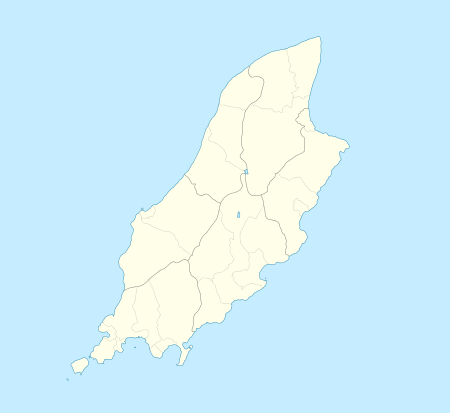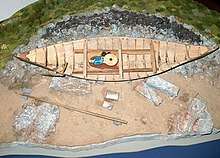Balladoole
Chapel Hill, Balladoole is a significant historical and archaeological site in Arbory on the Isle of Man.[1][2] The site is a short distance from Castletown in the south of the Island. It is located on a small hilltop overlooking the coast. Balladoole has undergone extensive archaeological excavations in the 20th century, most notably in 1944-1945 by German archaeologist Gerhard Bersu who was interned on the Isle of Man during World War II.[3][4]
 The stone outline of the Viking boat burial | |
 Map of the Isle of Man showing the location of Balladoole | |
| Location | Chapel Hill, Balladoole, Arbory |
|---|---|
| Region | Isle of Man |
| Coordinates | 54.07964°N 4.68203°W |
| History | |
| Periods | Mesolithic, Bronze Age, Iron Age, Medieval, Viking |
| Site notes | |
| Archaeologists | Gerhard Bersu, Basil Megaw, J.R. Bruce |
| Ownership | Manx National Heritage |
| Public access | Yes |
The site has been in ritual use for millennia: archaeological excavations of the hilltop have uncovered Mesolithic remains; a Bronze Age cist; an Iron Age hill fort; a Christian keeill (a small chapel); a Christian burial ground, and a Viking Age boat burial.[1][2][5]
Archaeological sites
Mesolithic remains
The excavated remains of middens belonging to the native hunter-gather communities on the site have provided evidence for human activity at Balladoole from the Mesolithic period.[6][7]
Bronze Age cist
The remnants of a small Bronze Age burial cist dating to c. 1000 BC are located on the north side of the site. It is missing a capstone,[8] and there are no records of any finds from inside the cist itself, although it is possible anything from the period may have been destroyed by later activity.[6] Tiny fragments of a Bronze Age cremation urn have been discovered below the floor of the Christian keeill.[9] This indicates that the original pre-historic burial site may have been reused by Christians centuries later.[9][10]
Iron Age hill fort
An earthwork promontory hill fort encircles the site.[11] Very little of the original stone that faced the earthwork survived although the amount of collapsed stone that was excavated suggests that the wall may have been as high as 3 metres in parts. A number of postholes that may have held up very large wooden gates have been excavated which has helped to date the hill fort.[5] The hill fort may have been used for defensive purposes although the large gaps in the earthwork have raised doubts about the defensive capability of the site.[6]

Keeill Vael
The remains of an ancient keeill on the site has been dated to between 900 AD and 1000 AD.[1][12] A keeill is a small simple chapel built between the 6th and 12th centuries on the Isle of Man.[13] It is this keeill that gave rise to the current name of the site: Chapel Hill.[12]
Very little of the original keeill remains. In the 19th century many of the stones were removed for building materials in local structures[14] so that the only architectural feature that remains is the doorway towards the west end of the south wall.[9] The keeill was built on top of an older, low paved platform.[9] The discovery of tiny fragments of a Bronze Age cremation urn below the keeill indicate that the Christians who built it reused an earlier Bronze Age structure.[14][15] Due to the very small size of the keeill, it would not have been used for congregational worship, but rather solely for liturgical purposes.[13]
Christian burial ground
Balladoole is also the site on an ancient Christian burial ground. Seventeen early Medieval stone lined lintel graves were excavated by Bersu in the 1940s.[15] Several of the graves were disturbed by the later Viking burial.[2][16]
Viking boat burial

The remains of an 11 metre long Viking boat that dates back to between 850AD and 950AD was excavated by Gerhard Bersu in 1945.[17] The boat was a clinker-built oak vessel and was typical of the trading vessels that travelled the trading routes in the Irish Sea during this period.[5] Although the boat timbers have long rotted away, the iron nails that held it together mark it's exact location and a stone cairn that is still visible today outlines the boat.[18] A large mound would have covered the site, but much of this was removed during Bersu's excavations as it was thought to make up part of the earlier Iron Age fortifications.[2]
The site is 350 metres uphill from the shore and is at the highest point of the hill, so it would have required significant manpower to bring the vessel to the site.[19] This indicates that the man interred in the boat was of high social standing in the community and may have been an important landowner, a chieftain, or a merchant.[5][10]
The burial cairn was covered with the cremated remains of animals and the presence of at least one additional corpse hints at the possibility of human sacrifice.[20][21] Significant grave goods were excavated from the Viking boat burial at Balladoole[20] and many are on display in the Manx Museum in Douglas:
These included a bronze ring-headed pin and a gilded belt buckle. There were also iron knives, a flint strike-a-light, and an iron cauldron. The most spectacular items, however, were a collection of riding gear, including a bridle, stirrups and spurs with ornamental buckles. There was also a shield, but no sword.[19]
The boat was buried directly on top of and into older Christian graves.[22] This may have been a deliberate slighting of the earlier graves, possibly as a sign of pagan Norse domination over the local Christian population.[18][22]
References
- "Balladoole Historic Monument Site". Visit Isle of Man. Retrieved 11 August 2020.
- Robinson, Vaughan; McCarroll, Danny, eds. (1990). The Isle of Man: Celebrating a Sense of Place. Liverpool: Liverpool University Press. p. 111. ISBN 0-85323-036-6.
- Chappell, Connery (2005). Island of Barbed Wire : the Remarkable Story of World War Two Internment on the Isle of Man. Ramsbury: Robert Hale. pp. 97–98. ISBN 978-0-7198-2443-2.
- "The Viking Burials: Discoveries in Jurby and Arbory Described". Isle of Man Times. 5 January 1946. Retrieved 11 August 2020.
- McDonald, Neil (2012). Isle of Man, A Megalithic Journey. Megalithic Publishing. pp. 87–88. ISBN 978-1-4475-9518-2.
- "Balladoole". iMuseum. Retrieved 11 August 2020.
- Jamieson, Andrew (2006). Ice, Water and Buried Treasure? Early Mesolithic Colonisation of the Isle of Man (MSc thesis). University of York. p. 37.
- "Chapel Hill (Isle of Man) - Hillfort in Channel Islands and Isle of Man in Isle of Man". The Megalithic Portal. 19 October 2008. Retrieved 11 August 2020.
- "Keill Vael". iMuseum. Retrieved 11 August 2020.
- "Museum on the Move - Balladoole". Manx National Heritage. Retrieved 11 August 2020.
- "Unravelling the Island's Past: Progress of Manx Archaeology". Isle of Man Examiner. 8 April 1955. Retrieved 11 August 2020.
- "Early Historical Sites: Balladoole". Isle of Man Guide. Retrieved 12 August 2020.
- Lowe, Christopher Edmund (1988). Early Ecclesiastical Sites in the Northern Isles and Isle of Man: An Archaeological Field Survey (PDF) (PhD thesis). University of Durham. p. 3.
- "Keeill Vael, Arbory". Manx Keeills. 5 July 2016. Retrieved 12 August 2020.
- Dirk, Steinforth (10 July 2016). "The Boat-Grave at Balladoole". The Mystery and the History of the Vikings in the Isle of Man. Retrieved 12 August 2020.
- The Viking Age in the Isle of Man. Select Papers from the Ninth Viking Congress (PDF). Ninth Viking Congress. 4–14 July 1981. p. 16. ISBN 0-903521-16-4. Retrieved 12 August 2020.CS1 maint: date format (link)
- "The Balladoole Boat Burial, Arbory". Viking Archaeology. Retrieved 12 August 2020.
- John, Hunter; Ralston, Ian, eds. (1999). The Archaeology of Britain: An Introduction from the Upper Palaeolithic to the Industrial Revolution. London: Routledge. pp. 198–200. ISBN 978-0415135887.
- "Chapel Hill, Balladoole Ship Burial". iMuseum. Retrieved 12 August 2020.
- Wilson, David (2008). The Vikings in the Isle of Man. Aarhus University Press. pp. 29–30. ISBN 978-8779343672.
- Shane, McLeod (2018). "Human Sacrifice in Viking Age Britain and Ireland". Australian Early Medieval Association: 76.
- Moore, R.H. (2012). "The Manx Keeill and pagan iconography: Christian and pagan responses to ideological turmoil in the Isle of Man during the tenth-century". Trowel. 13: 134–135 – via Academia.edu.